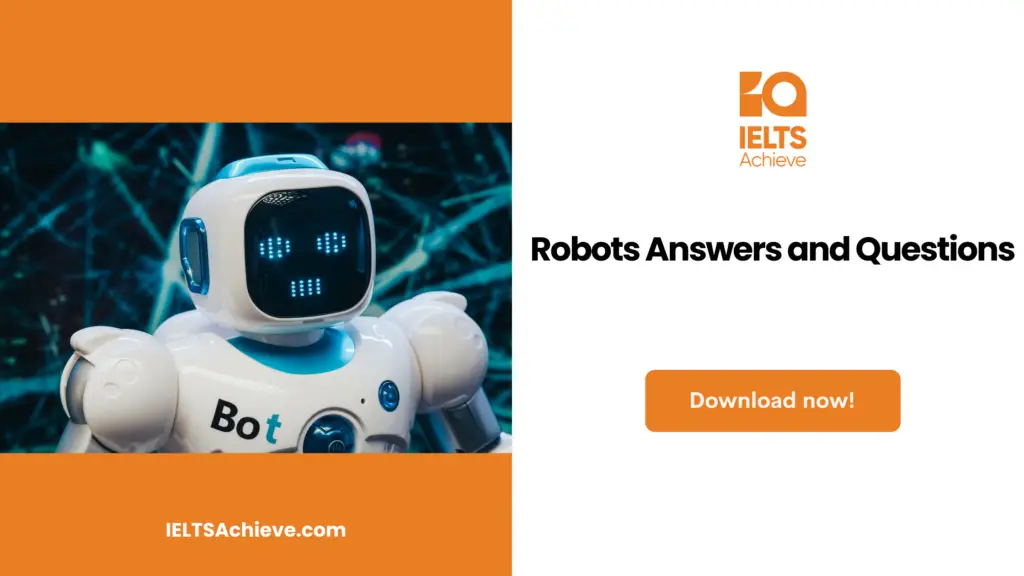The Blog post contains the following IELTS Reading Questions:
- IELTS Reading Matching Headings
- IELTS Reading Yes/No/Not Given
- IELTS Reading Summary Completion
Stay informed and prepared for success – Explore our comprehensive Reading Test Info page to get valuable insights, exam format details, and expert tips for mastering the IELTS Reading section.
IELTS Reading Passage – Robots

Robots
Since the origin of human ingenuity, humans have created an increasing variety of clever tools to handle nasty, dangerous, or tedious jobs. This tendency has resulted in robotics, the science of equipping machines with various human capabilities.
The modern world is being increasingly inhabited by semi-intelligent gadgets, whose presence we hardly notice but whose growing prevalence has eliminated significant human drudgery. Our factories are filled with the buzz of robot assembly arms. We perform our banking transactions at automated teller machines, which thank us politely for the transaction. The subway trains are operated by tireless robo-drivers. Our mine shafts are excavated by robotic moles, and nuclear disasters like Three Mile Island and Chernobyl are cleared away by radiation-resistant robotic muckers.Such is the broad range of uses anticipated by the Czech playwright Karel Capek, who introduced the word “robot” in 1920 (the Czech word “robota” translates to “forced labor”). As development speeds up, the experiment is becoming exploitable at a rapid pace.
Other developments promise to increase the capabilities of human operators. Due to the constant miniaturization of electronics and micromechanics, there are now robot systems that can perform various types of brain and bone surgeries with submillimeter precision and with far better accuracy than highly competent surgeons can accomplish with their hands alone. At the same time, long-distance control methods will keep people far enough from risk. In 1994, Dante, a ten-foot-tall NASA robotic explorer with spider-like legs and video camera eyes, scaled the deadly rim of an Alaskan volcano while experts were in California, 2,000 miles away, observing the action on a satellite and supervising Dante’s descent.
However, for robots to progress to the next phase of labor-saving utility, they must perform tasks with little human supervision and also be capable of making at least some decisions for themselves; these objectives are extremely difficult to achieve. According to one expert, we can’t yet give a robot adequate common sense to reliably deal with a dynamic world, although we understand how to tell a robot to solve a specific problem. In reality, the search for natural artificial intelligence (AI) has produced a variety of interesting results. Although there was a brief period of initial optimism in the 1960s and 1970s when it seemed that transistor circuits and microprocessors might become capable of performing equivalently to the human brain by the 21st century, researchers have already extended their estimations by decades, if not centuries.
In their attempt to model thought, they discovered that human perception is much more complicated than previously assumed and that the approximately 100 billion neurons in the human brain are much more skilled. They have created robots that can detect a fraction of a millimeter of misalignment in a machine panel in a regulated factory environment. However, the human mind can take in a scene that is changing quickly and ignore the 98% of it that is useless, instantly focusing on the woodchuck by the side of a meandering forest road or the lone questionable face in a bustling crowd. The most advanced computing systems on Earth cannot get near that level of capability, and neuroscientists are still not sure how we can achieve it.
Despite this, information theorists, neuroscientists, and computer specialists are merging their abilities to discover ways of giving robots a level of intelligence resembling that of humans. One method abandons the linear, logical layout of typical electrical circuits in favor of the disorderly, ad hoc arrangement of neurons in a real brain. These so-called “neural networks” don’t require programming. A system of feedback signals allows them to “teach” themselves by reinforcing the electrical pathways that create the correct answers and, in contrast, eliminating the connections that led to the wrong ones. Eventually, the net arranges itself into a system that can identify specific forms or pronounce particular phrases.
In some fields, researchers are attempting to establish a more organic relationship between humans and robots with the hope that one day machines could take over some duties presently carried out by people, like those in, for example, nursing homes. In Japan, where the number of senior residents is rapidly growing, this is particularly necessary. The Science University of Tokyo has therefore developed a “face robot” as a prototype, which is a life-size soft plastic replica with a female head, including a video camera inserted in the left eye. The objective of the researchers is to build robots that people are comfortable with. They are focusing on the face because they believe that the most efficient and crucial way to express emotional messages is through facial expressions. We analyze facial expressions to determine whether a person is happy, scared, angry, or nervous and interpret those messages. Thus, the Japanese robot is designed to recognize emotions in the individual it is “looking at” by detecting changes in the spatial arrangement of the individual’s eyes, nose, brows, and mouth. It determines the emotion by comparing the configurations with the database of common facial expressions. The robot then adjusts its plastic face to the right emotional response using a set of small pressure pads.
Instead of trying to imitate human intelligence or emotions, other labs are using a different strategy. In the same way that computer design has shifted away from a centralized mainframe to a multitude of separate workstations and single processors have taken a back seat to arrays of smaller units that divide a large problem into parts that can be tackled simultaneously, many scientists are now examining the possibility that large numbers of semi-intelligent robots could produce intelligence that is more than the sum of their parts. That’s what beehives and ant colonies do, and various teams are proposing that legions of tiny animals cooperating in ant colony patterns may be dispatched to investigate the climate of planets or to inspect pipes in unsafe industrial settings.
Unlock your full potential in the IELTS Reading section – Visit our IELTS Reading Practice Question Answer page now!
Recommended Questions:
Renewable Energy IELTS Reading Question with Answer
Robots IELTS Reading Questions
Questions 1 – 6
Reading Passage has seven A – G. From the list of headings below choose the most suitable heading for each paragraph. Write the appropriate numbers (i – x) in boxes 1 – 6 on your answer sheet.
- Paragraph A
- Paragraph B
- Paragraph C
- Paragraph D
- Paragraph E
- Paragraph F
| Example | Answer |
| Paragraph G | iii |
Ready to conquer Matching Headings questions? Click here to learn essential tips and techniques for matching headings accurately to paragraphs or sections in the IELTS Reading section.
Questions 7 – 11
Do the following statements agree with the information given in the Reading Passage? In boxes 7 – 11 on your answer sheet, write
YES if the statement agrees with the information.
NO if the statement contradicts the information.
NOT GIVEN if there is no information on this in the passage.
7. Robots are capable of making accurate visual judgments.
8. The present usage of robots was accurately predicted by Karel Capek.
9. The most advanced robotic systems are those of the Japanese.
10. The NASA robot named Dante saved lives.
11. The robots can replicate the internal functions of the brain.
Want to excel in identifying the writer’s views and claims? Click here to explore our in-depth guide on how to accurately determine Yes, No, or Not Given in the IELTS Reading section.
Questions 12 – 14
Complete the summary below with words taken from Paragraph F. Use NO MORE THAN THREE WORDS for each answer. Write your answers in boxes 12 – 14 on your answer sheet.
A (12.)_______ is installed inside the head of the Japanese “face robot” prototype, which is used to observe people. It then checks the (13.)________ of common facial expressions to determine what emotions the person is having. The robot uses several (14.)_______ to change its expression as a reaction to this expression.
Boost your performance in Summary, Notes, Table, and Flowchart Completion tasks. Click here to explore our detailed guide and learn how to effectively complete summaries, notes, tables, and flowcharts in the IELTS Reading section.
Unlock your full potential in the IELTS Reading section – Visit our IELTS Reading Practice Question Answer page now!
Recommended Questions:
Renewable Energy IELTS Reading Question with Answer
Robots Reading Answers
1. X
2. I
3. vii
4. ii
5. vi
6. viii
7. Yes
8. Yes
9. Not Given
10.Not Given
11. No
12. video camera
13. database
14. pressure pads

We hope you found this post useful in helping you to study for the IELTS Test. If you have any questions please let us know in the comments below or on the Facebook page.
The best way to keep up to date with posts like this is to like us on Facebook, then follow us on Instagram and Pinterest. If you need help preparing for the IELTS Test, join the IELTS Achieve Academy and see how we can assist you to achieve your desired band score. We offer an essay correction service, mock exams and online courses.

